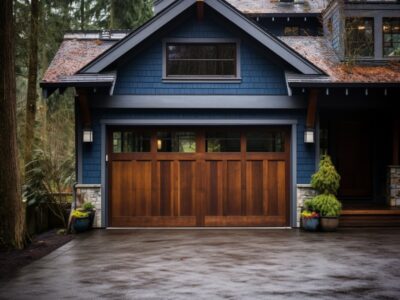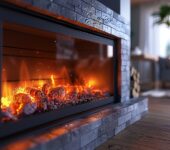Table of Contents
- 1 Is It Safe To Leave A Fire In The Fireplace Unattended?
- 2 What Are The Risks Of Leaving A Fire In The Fireplace Unattended?
- 3 How To Properly Extinguish A Fire In The Fireplace?
- 4 What Are The Alternatives To Leaving A Fire In The Fireplace Unattended?
- 5 Can I Leave A Fire In The Fireplace Unattended For A Short Time?
- 6 What Are The Safety Precautions To Take Before Leaving A Fire In The Fireplace Unattended?
- 7 Frequently Asked Questions
Leaving a fire in the fireplace unattended is a common dilemma for many property owners. While it may seem convenient to keep the fire burning while you step out for a short time, it can come with significant risks.
There are several dangers associated with leaving a fire unattended, from fire hazards to carbon monoxide poisoning.
In this article, we will explore the potential risks, how to properly extinguish a fire, alternative options, and safety precautions to consider before leaving a fire in the fireplace unattended.
So, can you leave a fire in the fireplace unattended? Let’s find out.
Is It Safe To Leave A Fire In The Fireplace Unattended?
Leaving a fire in the fireplace unattended raises significant concerns about household safety and fire risks.
Not only can an unattended fire lead to accidental property damage, but it can also pose serious threats to the well-being of those in the vicinity. Flames can quickly spread beyond the hearth, igniting surrounding materials and potentially engulfing the entire home in a destructive blaze.
In addition, the build-up of creosote in the chimney from burning fires without supervision can increase the likelihood of a chimney fire. It is vital to prioritize fire safety by never leaving a fire unattended and always ensuring that the fireplace is properly extinguished before leaving the area.
What Are The Risks Of Leaving A Fire In The Fireplace Unattended?
Leaving a fire in the fireplace unattended poses various risks, including fire hazards, carbon monoxide poisoning, and potential damage to the chimney structure.
Fire hazards from unattended fires can quickly escalate, leading to property damage and even endangering lives. The buildup of carbon monoxide in enclosed spaces, a byproduct of incomplete combustion, poses a severe health risk. Exposure to high levels of carbon monoxide can result in symptoms like headache, dizziness, and even death.
Neglecting a fire can also impact the integrity of the chimney, as the heat and creosote buildup can weaken the structure, presenting a serious safety concern.
Fire Hazards
Leaving a fire unattended in the fireplace can lead to indoor fires, open flames spreading, and create potential hazards within the home environment.
This negligence poses serious risks such as the ignition of nearby flammable materials like curtains or furniture. A small spark can quickly escalate into a full-blown fire, endangering lives and property. Uncontrolled flames can rapidly spread to other rooms, causing widespread damage.
To prevent these dangers, it is crucial to always ensure that fires are properly extinguished before leaving the area. Installing smoke alarms and having a fire extinguisher nearby are essential safety measures to protect against unforeseen emergencies.
Carbon Monoxide Poisoning
One of the risks of leaving a fire unattended is the potential for carbon monoxide poisoning, which poses a serious health risk to individuals in the household.
Carbon monoxide is a colorless, odorless gas that can have detrimental effects on the body when inhaled in large quantities. Symptoms of carbon monoxide poisoning include headaches, dizziness, nausea, confusion, and even unconsciousness. This gas is produced by the incomplete burning of carbon-based fuels like wood, gas, and oil.
Installing carbon monoxide alarms in your home is crucial to detect the presence of this gas early on. In the event of a carbon monoxide alarm going off, it is important to evacuate the premises immediately and seek medical assistance. Having a well-thought-out emergency plan in place can save lives in such situations.
Damaged Chimney
Leaving a fire unattended can lead to a damaged chimney, compromising its structural integrity and violating fire codes related to property maintenance.
This neglect can result in the buildup of creosote, a highly flammable substance, within the chimney, increasing the risk of a dangerous chimney fire. Beyond the immediate danger to property and lives, failing to maintain your chimney can also lead to costly repairs and potential legal consequences.
Insurance companies often require proof of regular chimney inspections to maintain coverage, and neglecting this maintenance can result in denied claims in the event of a fire. Regular chimney inspections are crucial for identifying and addressing issues before they escalate, ensuring the safety of your home and complying with relevant fire codes and property maintenance regulations.
How To Properly Extinguish A Fire In The Fireplace?
Ensuring the safe extinguishing of a fire in the fireplace is crucial for fire prevention and maintaining home safety.
To properly extinguish a fire in the fireplace, start by ensuring that the firewood is completely burned down to ash.
Use a fireplace poker to gently spread out the remaining embers and ash, allowing them to cool down gradually.
Never leave a fire unattended and always keep a fire extinguisher nearby for emergencies.
Make sure to close the fireplace doors to prevent any remaining sparks from escaping.
It’s essential to regularly clean your chimney to avoid the buildup of creosote, which can increase the risk of a chimney fire.
By following these safety precautions and fire prevention measures, you can enjoy the warmth of a fire in your fireplace while keeping your home and loved ones safe.
Use A Fireplace Screen
Using a fireplace screen is an effective safety measure to protect against sparks and embers, especially when dealing with flammable materials nearby.
The screen acts as a barrier, preventing stray sparks from igniting carpets, furniture, or any other combustible items in the room. By containing these tiny fiery elements, the screen plays a crucial role in reducing the risk of accidental fires. It also helps in maintaining proper airflow within the fireplace, ensuring that it burns efficiently and minimizing the release of harmful gases. Fireplace screens come in various designs, adding a touch of style to your living space while offering practical protection.
Close The Damper
Closing the damper after extinguishing the fire helps control ventilation and airflow, contributing to enhanced fire safety within the home.
By regulating the airflow, the damper ensures that the fire is completely extinguished by limiting the amount of oxygen available to it. This simple act not only prevents smoky backdrafts, which can release harmful toxins back into the living space but also plays a crucial role in maintaining the integrity of the chimney system. Properly closed dampers act as a barrier against sparks and embers that could escape and potentially ignite flammable materials nearby, reducing the risk of accidental fires and safeguarding the property and its occupants.
Remove Any Burning Logs
Before leaving the fireplace unattended, ensure to remove any burning logs or firewood from the hearth, demonstrating responsible fire safety behavior.
This practice is crucial in preventing potential fire hazards and ensuring the safety of your home and loved ones. Remember to always use appropriate tools, such as fireplace tongs or gloves, to handle the logs carefully. Never leave the fireplace unattended while it is still lit. Make sure the fire is completely extinguished before going to bed or leaving the house, and always keep a fire extinguisher nearby as an added precaution.
Pour Water Over The Embers
To extinguish the fire completely, it is advisable to pour water over the embers as an additional precautionary measure, especially if a fire extinguisher is not available.
This method can effectively cool down the burning material and prevent it from reigniting. When using water, it’s crucial to aim for the base of the fire to smother it entirely. The steam generated when water meets the heat helps to suffocate the flames by limiting the oxygen supply. Caution must be exercised with electrical fires or grease fires, as water can exacerbate these situations. Always ensure the area is safe before attempting to extinguish a fire with water.
Dispose Of The Ashes Safely
Safely disposing of ashes after extinguishing the fire is essential to prevent property damage and maintain effective fire prevention measures.
Improper disposal of fireplace ashes can lead to unexpected fires, posing a significant risk not only to the property but also to the safety of those in the vicinity. To ensure safety, wait at least 24 hours before handling ashes to allow them to cool completely. Use a metal container with a tight-fitting lid to store the ashes before disposing of them in a location away from flammable materials. Regularly removing ashes also improves the efficiency of your fireplace and reduces the buildup of combustible materials.
What Are The Alternatives To Leaving A Fire In The Fireplace Unattended?
Exploring alternatives to leaving a fire unattended in the fireplace includes options such as fireplace inserts, gas fireplaces, and electric fireplace models.
Fireplace inserts are a popular choice as they can increase the efficiency of traditional fireplaces, providing better heat output and reducing the risk of embers escaping.
Gas fireplaces are convenient, offering instant warmth at the touch of a button without the need for constant monitoring. On the other hand, electric fireplaces are clean and easy to maintain, often equipped with safety features like automatic shut-off mechanisms and cool-to-touch surfaces, making them a safe option for homes with children or pets.
Use A Fireplace Insert
Installing a fireplace insert offers efficient heating solutions with enhanced safety features, providing a viable alternative to traditional fireplaces.
By using a fireplace insert, you can enjoy the warmth and ambiance of a fire without worrying about sparks or embers escaping into your home. These inserts are designed with advanced safety mechanisms, such as tempered glass doors and sealed combustion systems, reducing the risk of accidental fires.
Fireplace inserts are highly energy efficient, delivering more heat output while consuming less fuel compared to traditional fireplaces. When selecting a suitable fireplace insert, consider factors like size, fuel type, and installation requirements to ensure optimal performance and compatibility with your existing setup.
Install A Gas Fireplace
Opting for a gas fireplace as an alternative to traditional wood-burning fires offers clean fuel, convenience, and ease of installation for property owners.
Gas fireplaces provide a cleaner and more eco-friendly fuel option compared to wood-burning fireplaces, as they produce fewer emissions and particulate matter. Operating a gas fireplace is also incredibly convenient, with just a simple flip of a switch or press of a remote control to ignite the flames. The installation process for gas fireplaces is relatively straightforward, requiring a gas line to be connected and ensuring proper ventilation for safety. This ease of installation makes it a popular choice for property owners looking to add a cozy and efficient heating source to their living spaces.
Use An Electric Fireplace
Electric fireplaces provide an energy-efficient heating option with flame simulation features, requiring minimal maintenance compared to traditional fireplaces.
These modern heating units offer the ambiance of a traditional fireplace without the need for chimneys or venting systems, making them versatile for various living spaces. With adjustable thermostat settings, property owners can easily control the temperature, leading to cost savings on energy bills. In addition, the flame simulation technology creates a cozy atmosphere while eliminating the safety concerns associated with real flames.
To maintain an electric fireplace, it is important to regularly clean the glass panel, dust the interior components, and inspect for any damage or wear to ensure safe and optimal performance.
Can I Leave A Fire In The Fireplace Unattended For A Short Time?
Leaving a fire in the fireplace unattended for a short time may be permissible with additional safety precautions and responsible behavior.
Before stepping away from the fire, it’s crucial to ensure that all flammable materials like curtains or newspapers are kept at a safe distance. Installing a proper spark guard can help prevent any embers from escaping the fireplace.
Never leave children or pets unattended around a burning fire. It’s advisable to check that the damper is fully open to allow for proper ventilation. Before leaving the area, double-check that the fire is completely extinguished to prevent any potential hazards.
What Are The Safety Precautions To Take Before Leaving A Fire In The Fireplace Unattended?
Before leaving a fire unattended in the fireplace, it is essential to take specific safety precautions, such as having a fire extinguisher and carbon monoxide detector on hand.
It is crucial to ensure that the flue is open to allow proper ventilation and prevent the buildup of dangerous gases. Regularly inspecting and cleaning the chimney can also reduce the risk of chimney fires. Making sure that any flammable items are kept at a safe distance from the fireplace and not overloading the fireplace with excessive amounts of wood are other important steps to take. By maintaining these safety measures and being proactive in fire prevention, the risk of accidents can be significantly mitigated.
Keep A Fire Extinguisher Nearby
Having a fire extinguisher within reach when leaving a fire unattended ensures emergency preparedness and protects the property from potential fire damage.
In case of a sudden fire outbreak, quick access to a fire extinguisher can be the difference between a minor incident and a major disaster. It’s crucial to familiarize yourself with the various types of fire extinguishers: water, foam, carbon dioxide, dry powder, and wet chemical, each designed for specific types of fires. Understanding the correct usage for each type is essential to effectively combat a fire. By acting swiftly with the right extinguisher, you can contain a fire before it spreads and causes extensive damage to your home or workplace.
Have A Carbon Monoxide Detector Installed
Installing a carbon monoxide detector is crucial for monitoring indoor air quality. Alarms trigger in case of elevated carbon monoxide levels, facilitating a prompt emergency response.
These detectors play a vital role in safeguarding residents against carbon monoxide poisoning. Carbon monoxide is a colorless and odorless gas. It can be lethal in high concentrations.
Carbon monoxide detectors emit loud, distinctive sounds when they detect unsafe levels of the gas. This warns residents to evacuate immediately. To ensure their effectiveness, install these detectors strategically throughout the home, especially near bedrooms and areas with fuel-burning appliances.
Regular maintenance is essential to ensure they are in optimal working condition. This includes testing the detectors monthly and replacing batteries as needed,
Regularly Clean And Maintain The Fireplace
Regularly cleaning and maintaining the fireplace is essential for preventing fire hazards. In addition, it ensures proper chimney function, and maintains overall fire safety standards.
This includes scheduling annual chimney inspections by a certified professional from Dreifuss. They will detect and remove any creosote buildup, debris, or blockages that could potentially ignite and cause a chimney fire. It is also crucial to dispose of ashes safely and properly to prevent any accidental fires. Property owners can significantly reduce the risks associated with flammable materials and enhance the overall fire safety in their homes. You can accomplish this by following these maintenance practices.
Frequently Asked Questions
1. Is it safe to leave a fire in the fireplace unattended?
Leaving a fire in the fireplace unattended is not safe. It can cause accidental property damage and pose serious risks like fire hazards and carbon monoxide buildup. Always extinguish the fire completely before leaving the area.
2. What are the risks of leaving a fire in the fireplace unattended?
The risks include potential fire hazards, carbon monoxide poisoning, and damage to the chimney structure. Unattended fires can lead to dangerous situations, affecting the safety of your home and health.
3. How to properly extinguish a fire in the fireplace?
To put out a fire in the fireplace, first, spread out the embers to cool. Next, close the fireplace doors to contain sparks. Finally, keep a fire extinguisher nearby. Regular chimney cleaning is essential to prevent creosote buildup and chimney fires.
4. Can I leave my house with a fire in the fireplace?
You should not leave your house with a fire in the fireplace. Even a small, seemingly controlled fire can escalate quickly. Always fully put out the fire completely before you leave the house.
5. What are the alternatives to leaving a fire in the fireplace unattended?
Consider using fireplace inserts, gas fireplaces, or electric fireplace models as safer alternatives. These options provide warmth without the risks associated with traditional wood-burning fireplaces.
6. What are the safety precautions to take before leaving a fire in the fireplace unattended?
First, ensure the fire is completely out. Then, keep flammable materials away. Next, check that the flue is open for ventilation. Finally, keep a fire extinguisher accessible. Install carbon monoxide detectors to monitor air quality.
Latest Articles

Garage Door With Glass Windows: Merge Aesthetics With Practicality
Table of Contents1 What Is a Garage Door with Glass Windows?2 What Are the Types of Glass Used for Garage Doors?3 What Are the Benefits

How Many Fireplaces Can I Have In My Home?
Table of Contents1 What Is a Fireplace?2 What Are the Different Types of Fireplaces?3 How Many Fireplaces Can You Have in Your Home?4 What Are

Window Garage Door: Framing Views, Enhancing Aesthetics
Table of Contents1 What Is a Window Garage Door?2 How Does a Window Garage Door Work?3 What Are the Benefits of Having a Window Garage



















































































